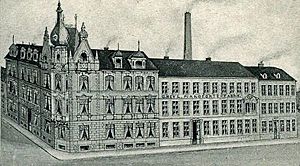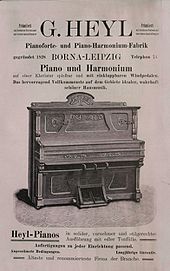Heyl (piano factory)
| G. Heyl Pianofortefabrik | |
|---|---|
| legal form | one-man business |
| founding | 1828 |
| resolution | 1935 |
| Seat | Borna near Leipzig |
| management | Thank God Heyl and his descendants |
| Number of employees | 70 (1913) |
| Branch | Musical instrument making |
The Pianofortefabrik Heyl is a former manufacturer of pianos and harmonies from Borna near Leipzig . The family business was one of the oldest piano producers in central Germany around Leipzig, alongside Blüthner and Schimmel . The invention and sale of the harmonium piano made the company one of the best-known piano manufacturers at the time in the area around Leipzig, which, along with Berlin, was a center of German piano manufacturing at the time.
history
From the beginnings under Gottlieb Heyl around 1800 to 1828
The tradition of piano making began in the Heyl family with Johann Gottlieb Heyl. Johann Gottlieb Heyl was born in 1770 in Rüben near Borna. With his wife Johanne Christine Zieck he had seven sons and a daughter. With great craftsmanship, he first built spinets . Since he had little business acumen, even the children were forced to work in the company or to earn extra income in choirs. Nevertheless, the eldest son Gottlob began an apprenticeship in his father's business in 1815. Later three other sons also joined the father.
Heyl took up the development of the table piano that began at the beginning of the 19th century , the type of piano on which musicians such as Clara and Robert Schumann , Franz Schubert and Richard Wagner later played and composed. Heyl's instruments were sent to more distant places in Saxony, e.g. B. to Altenburg , Waldenburg or Eilenburg . The sons delivered the goods on wheelbarrows to nearby towns .
The demand for square pianos and the associated production expansion led to a lack of space in their own home. Therefore, Heyl bought the house of the kit maker Gotthardt Simon in Bornaer "Entenpfuhl" (later Brühl) No. 158 to run a workshop for 305 thalers .
Gottlieb Heyl died in 1828. Shortly before, he had bequeathed his house and business to his eldest son Gottlob.
Founding of the factory under Gottlob Heyl in 1828
The handover to Gottlob Heyl is considered to be the founding date of the Pianofortefabrik Heyl. Gottlob Heyl initially continued the tradition of table pianos and was able to increase profits. He recognized numerous shortcomings in piano construction and finally refined his pianoforte, for which he now found large sales markets. His father's small workshop was soon no longer sufficient. In 1832 he therefore built the garden behind his house with additional workrooms.
By 1840 eight workers were already employed. His tabletop instruments were preferred to many other makes of the kind. In order to expand further, in 1846 he bought a piece of the Reissig's garden at the new gate, which was located behind his extension, and built work rooms on it where it was possible to work on 12 pianos at the same time. Thanks to piano fairs, his pianos were soon also in demand abroad.
From around 1850 the vertically aligned pianinos became popular and conquered the middle class household. The term “piano plague” arose for the large number of unmusical middle-class daughters who unswervingly contributed to the environmental noise of the time with their clinking. Now Gottlob Heyl began to align his production accordingly. The production numbers quickly rose into the hundreds.
In the meantime the third generation, Gottlob's sons Emil and Gustav, had grown up. They began their apprenticeship in piano making, albeit outside of their father's factory. After stays abroad they worked in the Heyl'schen piano factory. The sale of instruments continued to grow. A larger wood storage area was now necessary. Heyl bought a large part of the adjacent Schmalz'schen Garten and built two-story buildings there. In 1864 the factory had 16 employees and 2,000. Instrument was delivered. When Gottlob Heyl handed over the business in equal parts to his sons in 1872 for reasons of age, there were already 20 workers.
Gottlob Heyl died on October 31, 1874.
From 1872: The third generation, Gustav and Emil Heyl
Under Gustav and Emil Heyl, the 3,000. Instrument delivered. The large sales figures led to the switch to steam operation. Now a band saw, a drill, a circular saw, a spinning machine and a horizontal plumbing saw were operated with steam power. In 1874 35 workers were employed. In 1877 the brothers acquired a larger steam boiler and a vertical fournier saw, a decoupling saw, as well as a milling and planing machine. In 1879 production was already 5,000 instruments delivered. Now the brothers bought a house in Brühl, the Schlichter'sche Haus in the neighborhood.
It was now possible to build larger wings. The pianos were often sent to England and the English colonies in large orders. There were now 50 workers. To create more space for modern factories, the brothers tore down the older buildings and the father's house in 1885 and erected the stately corner building with the tower top.
In 1892, the company also began building combination instruments made of piano and harmonium , so-called piano harmonies with the brand name Dyophon . There was a cooperation with the Borna harmonium company Lindholm, which had no possibility of spatial expansion. In the following year, the 10,000. Instruments are festively celebrated. The company employed around 60 workers at that time. Emil Heyl died on November 15, 1897, and Gustav Heyl continued to run the company on his own.
In 1903 the company celebrated its 75th anniversary. On this occasion Gustav Heyl was awarded the Albrechtskreuz 1st class by the King of Saxony .
Gustav Heyl died on October 9, 1908.
From 1908: the fourth generation and the end
After Gustav Heyl had already involved his son Walter in the company during his lifetime, he and Fritz Heyl took over the business. In 1912 it was 15,000. Instrument exported to Australia. Before the First World War, the workforce could be increased to 70 employees. At the Leipzig Autumn Fair in 1923, the company showed a selection of its instruments. The "baby wing" received special attention.
Nevertheless, the company was not spared from inflation and post-war turmoil and had to temporarily stop operations. The factory was reopened in 1926, so that despite the conversion to more machines, three quarters of the former workforce was soon able to find work again.
In 1928 the piano factory celebrated its 100th anniversary. At that time, over 24,000 Heyl instruments had already been exported to all parts of the world.
In 1935 the company was dissolved and went out. The buildings are torn down.
Products
In the course of its over one hundred year history, the G. Heyl company built
- Spinets
- Table pianos
- Pianinos
- Wings and
- Dyophone, a combination of piano and harmonium
literature
- Martha Novak Clinkscale: Makers of the piano, 1700-1820 . Oxford University Press, 1993-1999, ISBN 978-0-19816323-7 .
- F. Robert Gellerman: Gellerman's International Reed Organ Atlas. Vestal Press; 2nd edition, 1998, ISBN 978-1-87951134-7 .
Web links
Individual evidence
- ^ Emil Breslaur, Anna Morsch: Information from piano manufacturing. In: Music pedagogical sheets. Central sheet for the entire musical education system, Volume 35. Peiser Verlag, Berlin 1912. P. 95.
- ↑ https://archive.org/details/pianosandtheirm00dolggoog Alfred Dolge: Pianos and their makers. A comprehensive history of the development. Covina, California. Covina publishing company, 1911. p. 231.
- ↑ Piano plague Internet Archive. Object database. Hermann Ruth-Sommer: Old musical instruments. Richard Carl Schmidt publishing house, Berlin 1909. p. 80.
- ^ Wolfram Robert: Chronicle of the city of Borna with consideration of the surrounding localities. Borna publishing house, 1886.
- ^ Robert F. Gellerman: Gellerman's International Reed Organ Atlas. P. 98.
- ↑ On the 75th anniversary of the G. Heyl piano factory in Borna , Zeitschrift für Instrumentenbau, Vol .: 23, Leipzig, 1902-03, p. 728 (digitized)
- ↑ Gustav Heyl † , Zeitschrift für Instrumentenbau, Vol .: 29, Leipzig, 1908-09, p. 223 (digitized)
- ↑ From abbey to onion house: an encyclopedia on the history of the city of Borna. Friends of the Borna Museum, 2001. p. 265.
- ↑ On the 100th anniversary of the G. Heyl piano factory in Borna near Leipzig , Zeitschrift für Instrumentenbau, Vol .: 49, Leipzig, 1928-29, p. 214 (digitized)
- ^ Hubert Henkel: Lexicon of German piano makers. Volume 73 of the textbook series Das Musikinstrument. Edition Bochinsky, Frankfurt am Main 2000.





